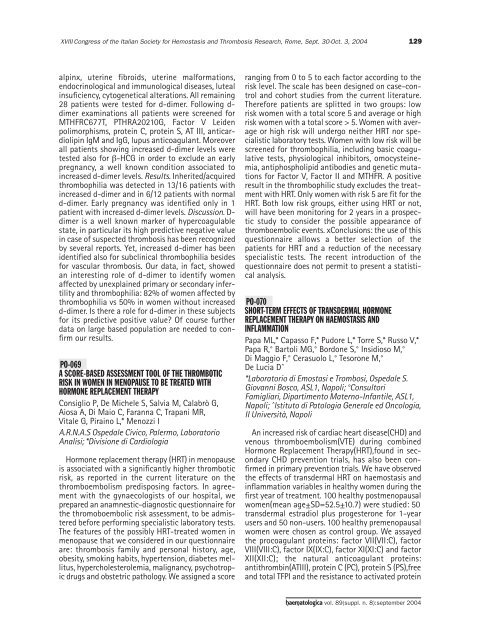Haematologica 2004;89: supplement no. 8 - Supplements ...
Haematologica 2004;89: supplement no. 8 - Supplements ...
Haematologica 2004;89: supplement no. 8 - Supplements ...
- No tags were found...
Create successful ePaper yourself
Turn your PDF publications into a flip-book with our unique Google optimized e-Paper software.
XVIII Congress of the Italian Society for Hemostasis and Thrombosis Research, Rome, Sept. 30-Oct. 3, <strong>2004</strong>129alpinx, uterine fibroids, uterine malformations,endocri<strong>no</strong>logical and immu<strong>no</strong>logical diseases, lutealinsuficiency, cytogenetical alterations. All remaining28 patients were tested for d-dimer. Following d-dimer examinations all patients were screened forMTHFRC677T, PTHRA20210G, Factor V Leidenpolimorphisms, protein C, protein S, AT III, anticardiolipinIgM and IgG, lupus anticoagulant. Moreoverall patients showing increased d-dimer levels weretested also for β-HCG in order to exclude an earlypregnancy, a well k<strong>no</strong>wn condition associated toincreased d-dimer levels. Results. Inherited/acquiredthrombophilia was detected in 13/16 patients withincreased d-dimer and in 6/12 patients with <strong>no</strong>rmald-dimer. Early pregnancy was identified only in 1patient with increased d-dimer levels. Discussion. D-dimer is a well k<strong>no</strong>wn marker of hypercoagulablestate, in particular its high predictive negative valuein case of suspected thrombosis has been recognizedby several reports. Yet, increased d-dimer has beenidentified also for subclinical thrombophilia besidesfor vascular thrombosis. Our data, in fact, showedan interesting role of d-dimer to identify womenaffected by unexplained primary or secondary infertilityand thrombophilia: 82% of women affected bythrombophilia vs 50% in women without increasedd-dimer. Is there a role for d-dimer in these subjectsfor its predictive positive value? Of course furtherdata on large based population are needed to confirmour results.PO-069A SCORE-BASED ASSESSMENT TOOL OF THE THROMBOTICRISK IN WOMEN IN MENOPAUSE TO BE TREATED WITHHORMONE REPLACEMENT THERAPYConsiglio P, De Michele S, Salvia M, Calabrò G,Aiosa A, Di Maio C, Faranna C, Trapani MR,Vitale G, Pirai<strong>no</strong> L,* Me<strong>no</strong>zzi IA.R.N.A.S Ospedale Civico, Palermo, LaboratorioAnalisi; *Divisione di CardiologiaHormone replacement therapy (HRT) in me<strong>no</strong>pauseis associated with a significantly higher thromboticrisk, as reported in the current literature on thethromboembolism predisposing factors. In agreementwith the gynaecologists of our hospital, weprepared an anamnestic-diag<strong>no</strong>stic questionnaire forthe thromoboembolic risk assessment, to be admisteredbefore performing specialistic laboratory tests.The features of the possibly HRT-treated women inme<strong>no</strong>pause that we considered in our questionnaireare: thrombosis family and personal history, age,obesity, smoking habits, hypertension, diabetes mellitus,hypercholesterolemia, malignancy, psychotropicdrugs and obstetric pathology. We assigned a scoreranging from 0 to 5 to each factor according to therisk level. The scale has been designed on case-controland cohort studies from the current literature.Therefore patients are splitted in two groups: lowrisk women with a total score 5 and average or highrisk women with a total score > 5. Women with averageor high risk will undergo neither HRT <strong>no</strong>r specialisticlaboratory tests. Women with low risk will bescreened for thrombophilia, including basic coagulativetests, physiological inhibitors, omocysteinemia,antiphospholipid antibodies and genetic mutationsfor Factor V, Factor II and MTHFR. A positiveresult in the thrombophilic study excludes the treatmentwith HRT. Only women with risk 5 are fit for theHRT. Both low risk groups, either using HRT or <strong>no</strong>t,will have been monitoring for 2 years in a prospecticstudy to consider the possible appearance ofthromboembolic events. xConclusions: the use of thisquestionnaire allows a better selection of thepatients for HRT and a reduction of the necessaryspecialistic tests. The recent introduction of thequestionnaire does <strong>no</strong>t permit to present a statisticalanalysis.PO-070SHORT-TERM EFFECTS OF TRANSDERMAL HORMONEREPLACEMENT THERAPY ON HAEMOSTASIS ANDINFLAMMATIONPapa ML,* Capasso F,* Pudore L,* Torre S,* Russo V,*Papa R,° Bartoli MG,° Bordone S,° Insidioso M,°Di Maggio F,° Cerasuolo L,° Tesorone M,°De Lucia D^*Laboratorio di Emostasi e Trombosi, Ospedale S.Giovanni Bosco, ASL1, Napoli; °ConsultoriFamigliari, Dipartimento Mater<strong>no</strong>-Infantile, ASL1,Napoli; ^Istituto di Patologia Generale ed Oncologia,II Università, NapoliAn increased risk of cardiac heart disease(CHD) andve<strong>no</strong>us thromboembolism(VTE) during combinedHormone Replacement Therapy(HRT),found in secondaryCHD prevention trials, has also been confirmedin primary prevention trials. We have observedthe effects of transdermal HRT on haemostasis andinflammation variables in healthy women during thefirst year of treatment. 100 healthy postme<strong>no</strong>pausalwomen(mean age±SD=52.5±10.7) were studied: 50transdermal estradiol plus progesterone for 1-yearusers and 50 <strong>no</strong>n-users. 100 healthy preme<strong>no</strong>pausalwomen were chosen as control group. We assayedthe procoagulant proteins: factor VII(VII:C), factorVIII(VIII:C), factor IX(IX:C), factor XI(XI:C) and factorXII(XII:C); the natural anticoagulant proteins:antithrombin(ATIII), protein C (PC), protein S (PS),freeand total TFPI and the resistance to activated proteinhaematologica vol. <strong>89</strong>(suppl. n. 8):september <strong>2004</strong>
















